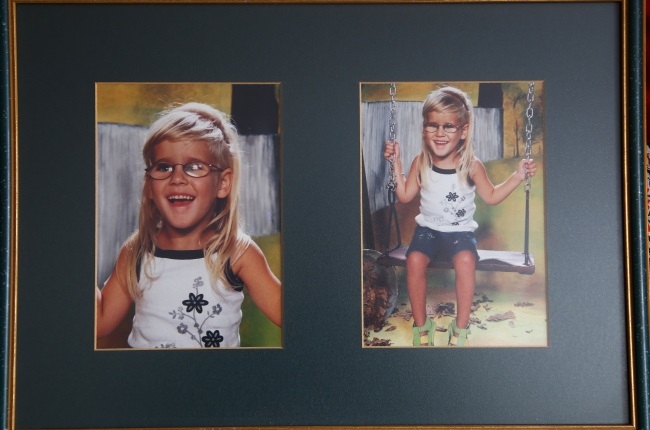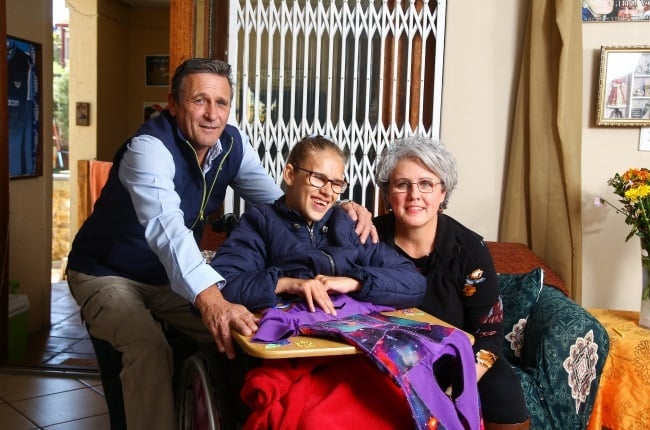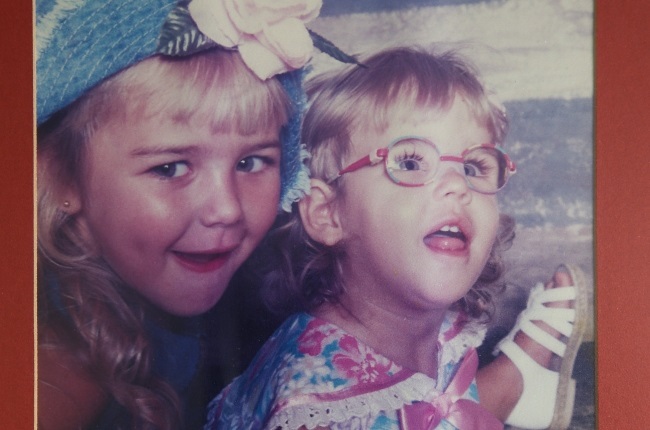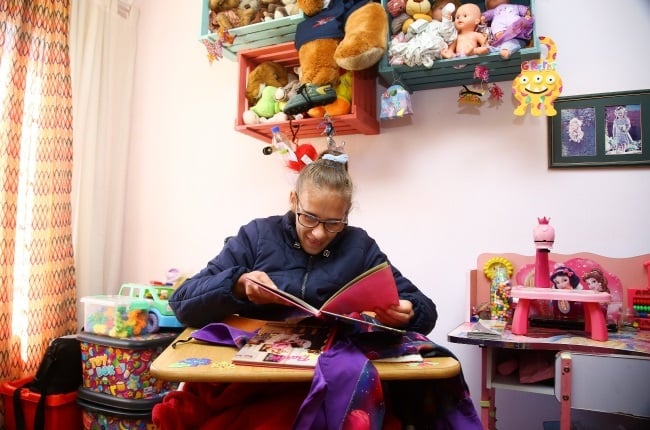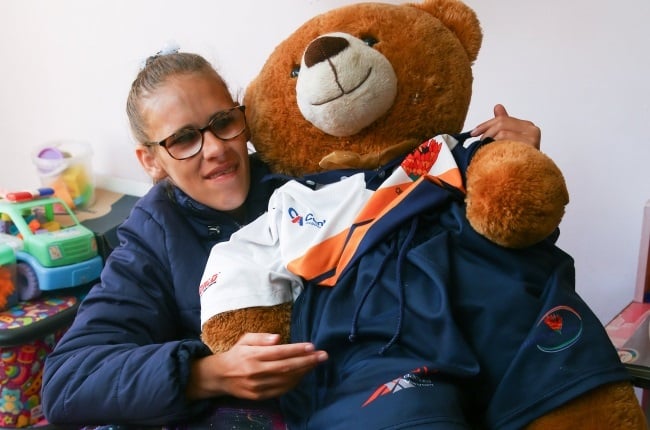
Her condition is so rare there were only six people in the world with it when she was diagnosed at the age of three.
She wouldn’t live long, her parents were told. She had Richards-Rundle syndrome, a neurodegenerative disorder that causes hearing loss, visual impairment, muscle atrophy, stunts mental development, and worsens with age.
But Danelle le Roux has defied the odds. She’s now 27 and although life has many challenges she’s a living miracle – and it’s largely thanks to her parents, Sophia and Pieter, that she has the quality of life she has today.
“We had to do a lot for her but she was sitting by the time she was a year old,” Sophia says. “We took her to speech therapy, horse therapy, and physiotherapy and she was walking and talking.”
“She even has a trophy from crèche that she won for running,” Pieter adds.
However, Danelle’s condition has indeed worsened with age. She can no longer walk or talk and her parents have to do almost everything for her. Yet they continue to try to look on the bright side and do everything they can to make sure she has as much quality of life as possible.
“Hearing about her diagnosis was very difficult,” Sophia says. “You can’t help but blame yourself and think you might have done something wrong to cause it even though you were told you didn’t.”
The worst part was hearing they would almost certainly outlive their child, which makes each year they have with her a bonus. “When she was diagnosed, the oldest living person with Richards-Rundle syndrome we could find was 23 years old. But Danelle is now 27 and that’s a miracle for us.”
The family home in Centurion, which is filled with pictures of Danelle and her older sister, Natasha (29), has been adapted to make it wheelchair-friendly with ramps instead of steps, and things at a lower level for easier access.
Mallie, the family dog, greets us at the front door and then dashes off to fetch Danelle. The dog adores her, Sophia says. “They’re similar in that they don’t like people touching them but they sometimes play together.”
Danelle and Mallie both have hearing difficulties – the dog is deaf and Danelle started losing her hearing when she was two years old.
Over the years her legs have atrophied. She has had several operations to release her tendons and for a while, she was able to walk with the aid of leg braces, but that eventually became impossible and she started using a wheelchair full-time in 2007.
As Sophia and Pieter talk to us, they adjust Danelle’s wheelchair and help her settle down to colour in some worksheets.
Danelle’s disorder prevented her from going through puberty. “She’s like a 12-year-old girl,” Sophia says.
She and Pieter help Danelle with basic tasks such as bathing, going to the bathroom and dressing.
While she’s unable to talk, she has no problem making herself understood, Sophia tells us.
“She has a temper – if she doesn’t want to do something, she won’t do it. She hates crowds and she has a very sweet tooth,” Pieter says.
“She’s also partial to a lamb chop. When we have a braai, we invite our friends over and have a good time. If Danelle gets bored she can go to her room and all her stuff is there waiting for her.”
Sophia works as an administrator at the University of Pretoria and Pieter is a national security manager at a logistics company.
Danelle attends the El-Shalem Haven in Pretoria, a private school for children with disabilities.
“And without fail every morning, Danelle will always argue with us about what she wants to wear. You’ll pick out an outfit for her and she’ll shake her head. Half the time the cupboards are half-empty before she decides what to wear,” Sophia says.
In 2008, the family moved to Dubai for Pieter’s work but they were back in South Africa three years later.
“It just wasn’t home,” Pieter says. “The level of care and respect for the disabled isn’t the same as it’s here.”
Their extended family and circle of friends help the Le Rouxs care for Danelle and also assist where they can with her expenses. Her school, for example, costs R9 000 a month, and her medical costs are high too.
“We have medical aid, but it doesn’t cover everything. For instance, they pay for only 12 physiotherapy sessions a year and Danelle needs two sessions a week. She also wears nappies,” Pieter says.
“When we needed to replace her wheelchair, the medical aid paid only half the cost. It’s been hard at times, but when we’ve reached out to our family and friends, they’ve helped us tremendously.
It's important to her parents that Danelle is as independent as possible.
When they discovered late last year that she was struggling to sit upright, she went for X-rays which revealed she had scoliosis, the curvature of the spine, which would worsen if left untreated.
To avoid going under the knife, Sophia and Pieter approached Bradley Beckerleg and Riaan Fourie, medical orthotists and prosthetists, who could customise an imported Sensory Dynamic Orthosis suit for Danelle.
When the couple heard the suit would cost R35 000, they thought it out of their reach.
“We asked our friends and family for help and one of them got in touch with Caring Daisies, an NPO in Pretoria, and they paid for the suit. I don’t have the words to explain how grateful we are,” Sophia says.
The suit, which resembles a swimming costume, is made mainly of Lycra and helps keep Danelle upright when sitting. The two-piece purple and pink suit zips together.
“Her quality of life has been amazing since she got the suit,” Sophia says.
“She can sit in an upright position and is able to do more for herself, and it supports her daily mobility comfortably.
“She also doesn’t have the pain and aches she did before at night after a day-long struggle to stay upright.”
The family say they are speaking out about Danelle’s condition hoping that they can help and encourage other families who have a disabled child.
“People sometimes stare at her and children come up to us and ask questions,” Sophia says, adding they welcome all the questions. “It helps to open up about it and explain things as best as you can.”
Sophia and Pieter have learnt to accept their daughter’s disability over the years. “In the beginning, I used to ask God, ‘Why us?’”, Sophia admits. “But we have each other, and our family and friends are very supportive. Danelle’s not a burden – she’s a blessing.”
Richards-Rundle syndrome is an extremely rare neurodegenerative disorder characterized by progressive spinocerebellar ataxia, sensorineural hearing loss, reduced function of the gonads (testes in males or ovaries in females) associated with additional neurological manifestations (such as peripheral muscle wasting, nystagmus, intellectual disability or dementia) and high levels of ketone bodies in the urine.
Symptoms for this syndrome most commonly appear between the ages of 1 to 23 months and differ from person to person.
Some people may have more symptoms than others and symptoms can range from mild to severe. Some symptoms may involve more than one body system.
The body systems are the cardiovascular system, respiratory system, musculoskeletal system, nervous system, digestive system, endocrine system, immune system, skin system, urinary system, and reproductive system.
The syndrome is named after doctors B.W Richards and AT Rundle who first wrote about the syndrome in 1953.
Sources: rarediseases.info.nih.gov, rarediseases.oscar.ncsu.edu




 Publications
Publications
 Partners
Partners





